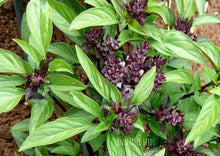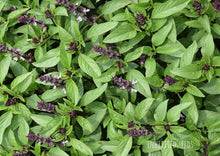But heirloom licorice basil is more than just a tasty herb - it's also packed with nutrients. Like other basil varieties, it is high in vitamin K and It is also a good source of antioxidants, which can help to protect the body against harmful free radicals.
In the kitchen, heirloom licorice basil is a versatile ingredient that can be used in a wide range of dishes. Its unique flavor pairs well with sweet and savory foods alike, making it a great choice for adding depth of flavor to desserts, cocktails, and more.
If you're looking to add some excitement to your garden and cooking, consider growing heirloom licorice basil. This rare and flavorful herb is sure to become a staple in your kitchen and a conversation starter in your garden.
Planting
- Kickstart the seeds indoors 6 weeks before the last spring frost.
- Basil prefers warmer temperature, wait until the soil has warmed to at least 50°F (daytime and night time temperatures). Basil grows best when the outside temperature reaches 70⁰F.
- Basil prefers full sun and grows best in a location that gets 6 to 8 hrs of full sun daily. They do well in partial sun locations as well.
- Soil should be moist but well-drained. Basil grows well in containers or raised beds, as these allow for better drainage.
- Companion plants: Tomatoes make great companion for basil plants in the garden.
Care
- Basil plants like moisture, mulching helps cool the plant (during host days) and ensure even moisture.
- Pruning helps branches multiply and more harvest. Simply trim the tips after every six sets of leaves
- Every time a branch has six to eight leaves, repeat pruning the branches back to their first set of leaves.
Harvest
- Start picking the leaves of basil when the plants reach about 8 inches tall.
- Leaves are most flavorful before sunrise, harvest early morning for the best taste. Pick the leaves regularly to encourage growth throughout the summer.
Pests / Diseases
Root Knot Nematode: Galls on roots which can be up to 1 inch in diameter but are usually smaller; reduction in plant vigor; yellowing plants which wilt in hot weather.
Control / Prevention: Plant resistant varieties if nematodes are known to be present in the soil; check roots of plants mid-season or sooner if symptoms indicate nematodes; solarizing soil can reduce nematode populations in the soil.
Aphids: Yellow leaves; distorted flowers/fruit; sticky “honeydew”; sooty, black mold that forms on honeydew; large presence of ants on plants.
Control / Prevention: Grow companion plants to either repel aphids away; knock aphids off plants with water spray, apply insecticidal soap; put banana or orange peel around plants; wipe leaves with a 1-2% solution of liquid dish soap, water every 2-3 days for 2 weeks.
Flea Beetles: Numerous tiny holes in leaves.
Control / Prevention: Use row covers to physically block flea beetles; mulch heavily; add native plants to attract beneficial insect predators.
Click here to download our free vegetable growing guide




